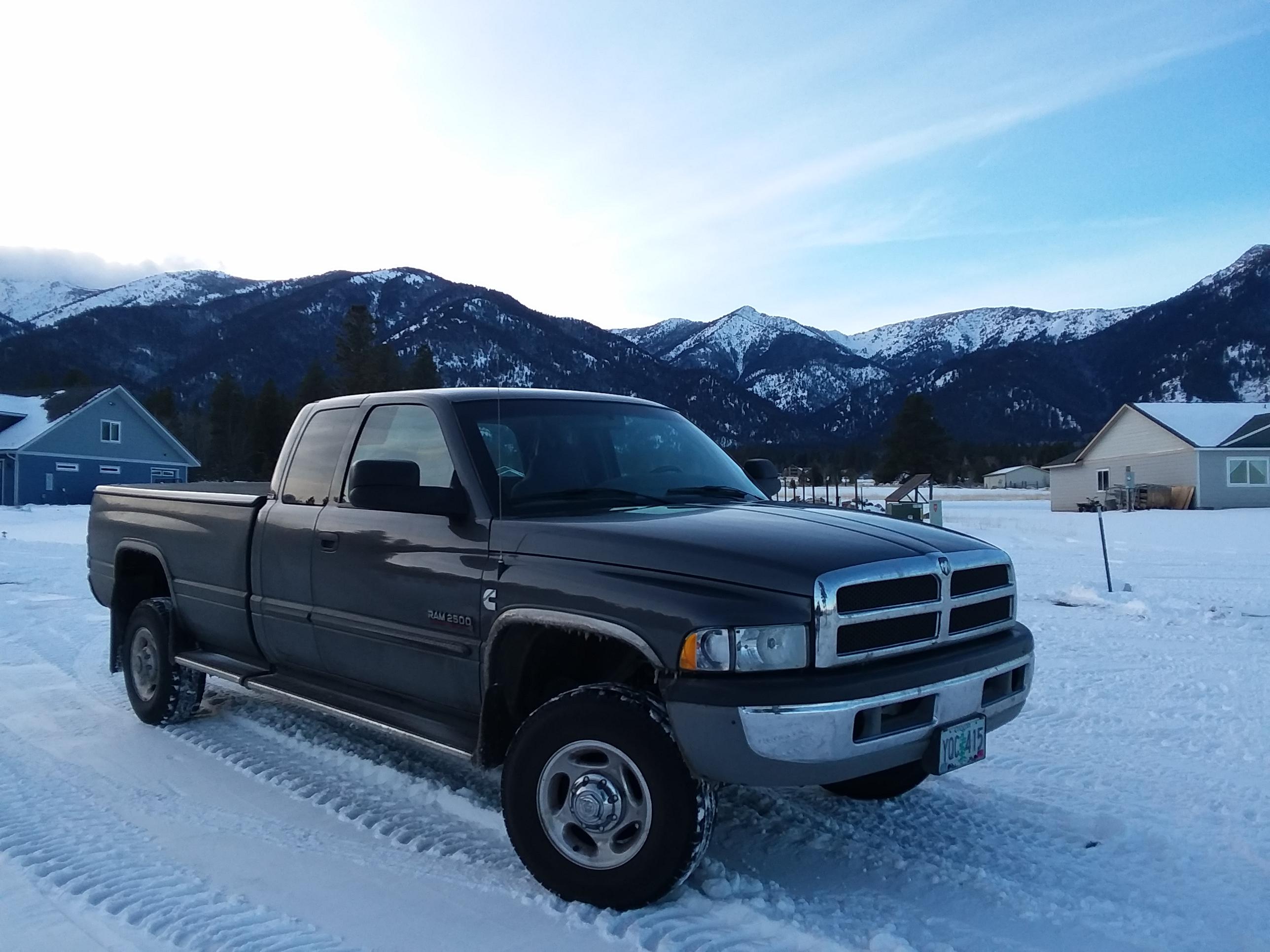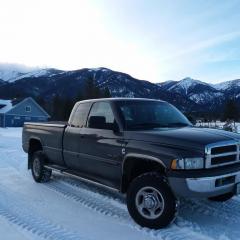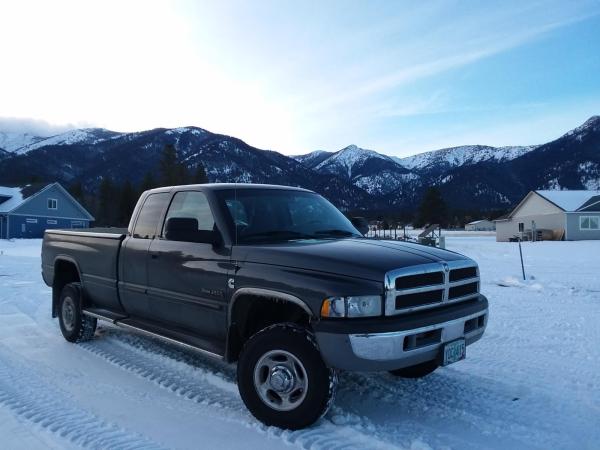
Everything posted by Tractorman
-
2000 Cummins Surge/Dead Pedal
This doesn't mean that the APPS is faulty - it just means that there is an output signal at idle when there shouldn't be. Need to know where it is coming from. More troubleshooting needed. Since I don't know what your level of skill is with electricity, I will just start with the basics. Let's say you wanted to check the condition of the crossover cable by using a voltage drop test. First, you would need to understand what would be normal for the test results. There are two batteries (wired in parallel) and a starter on your truck. The starter will draw at least 400 amps when cranking. This means that 200 amps will be supplied by each battery. Consequently, when the starter is operating, the positive and negative cable of the driver side battery and the positive (crossover cable) and negative cables of the passenger side battery will be handling 200 amps each. By design there will always be a voltage drop during the starter operation - there has to be, otherwise current would not flow. The maximum allowable voltage drop in a complete positive circuit is generally .5 volts and in a complete negative circuit is generally .2 volts. The positive circuit has a higher allowable voltage drop because there are usually more switches and connection points than in a negative circuit. Voltage drop measurements can be taken at different points with a voltmeter while the circuit is under an electrical load. Voltage drop tests taken without the circuit under an electrical load will show results that are meaningless. So, back to performing a voltage drop test on the crossover cable. This usually works best using two people. One person will be in the cab and will crank the engine as instructed for a specified period of time. Be sure to be safe - truck in neutral / park and park brake set. Remove the fuel pump relay (in the PDC) for the VP44. This will allow the engine to crank continuously without starting. Set your voltmeter to a manual DC voltage scale of two decimals - example: battery shows 12.67 volts DC on the meter. Do not use the floating scale. Place and hold the positive lead onto the passenger side positive post of the battery (the actual post, not the clamp). Place and hold the negative lead onto the eyelet at the other end of the crossover cable. Your meter should read 0 volts. Instruct the other person to crank the engine for 10 seconds (no interruption). A reading of .1 volts or less during engine cranking indicates that the crossover cable is in very good condition. A reading of .7 volts (for example) during engine cranking would indicate that the cable needs to be replaced. This voltage drop test allows you to see the true condition of the crossover cable while over 200 amps are passing through - a real life situation. John
-
2000 Cummins Surge/Dead Pedal
It sounds like you have confirmed that a false signal is being generated in the APPS output circuit. It would stand to reason that the engine rpm's would increase if a signal is present. Back to a previous statement of mine that was meant as a question - are you using the starter for a heavy electrical load when performing your voltage drop tests? By the way, my throttle APPS output always showed zero at idle on the OBDLink scanner. John
-
20190107_154237.jpg.33f191c1cd5cfedeb21cb36d12797070.jpg
-
2000 Cummins Surge/Dead Pedal
Glad to see you are performing voltage drop tests. Which wire has the .5 voltage drop? I am assuming that you are using the starter for the load while reading these values. I have a Timbo APPS on my truck. I will test it with my OBDlink LX for behavior at idle when I go to town later, and then report back. John
-
July 2025 Truck of the Month – Enter Now!
Cool! John
-
1994 12v losing fuel prime after sitting a few days - FASS pump problems? Help?
You should know if you found the problem after letting the truck set for a couple of days. If it fires right up, then I think you have solved the issue. Do you have a fuel pressure in the cab of your truck? John
-
1994 12v losing fuel prime after sitting a few days - FASS pump problems? Help?
Why do you think your fuel pump is weak? If, in fact, the water separator was the problem, the symptoms that you had - matched the problem. Once enough air was introduced into the suction side of the pump, the pump would struggle to move fuel because the vanes would have been spinning in air - not fuel. This would especially be problematic if the fuel level was low, as the fuel would have to be lifted higher. During your testing, you loosened the downstream filter to help displace the air, but the lift pump still had a source to draw more air (the water separator). Then, when you corrected that issue, the lift pump still did not have any fuel around the vanes, consequently the lift pump still had some difficulty getting primed. Completely normal. Now that fuel is surrounding the vanes in the lift pump and the air leak is fixed, the lift pump will always be primed and ready to start the engine quickly. I think that your lift pump is fine. John
-
1994 12v losing fuel prime after sitting a few days - FASS pump problems? Help?
Exactly what I would expect. The voltage will bump to above 12 volts with the engine running and voltage at the battery rises to around 14 volts. You could try taking apart the lift pump. I have heard that there can be problems with the relief valve ball and spring - both with Air Dog and FASS. John
-
Mysterious Knock on VP44 Truck – Need Help! No one can figure this out!
Set up your inhibiting tool again and cover the end of the tail pipe with your gloved hand (or block of wood) to see if you can feel a cylinder miss. Do the test with the inhibitor on and with it off. Actually, do three tests - inhibitor on, inhibitor off (within the first 10 seconds), and then with the inhibitor off after the noise returns. If there is a miss, you should be able to tell if it is random, multiple cylinders, or just one cylinder. I am just trying to think of ways to get some useful information. I agree that even though it sounds mechanical, why does the sound go away when certain conditions are met? I wouldn't rule out either a timing knock or something mechanical at this point. What about that tone ring? Were you able to perform a complete inspection of the whole tone ring? John
-
1994 12v losing fuel prime after sitting a few days - FASS pump problems? Help?
But, you can check the voltage at the pump with the pump running. Just probe the wire at the connector and connect the positive lead of you meter. Connect the other lead to the same ground used by the pump. I would expect to see right at 12 volts (maybe slightly less) with the ignition key on, lift pump running, and engine not running. If you see significantly less voltage, then either you have a poor electrical connection, or you have a lift pump that is drawing an abnormal amount of current. I see that there are two fuel filters with your FASS system. Is one a strainer and the other a filter, or are they both downstream filters? Is it possible for one to be plugged? Just covering all bases. John
-
1994 12v losing fuel prime after sitting a few days - FASS pump problems? Help?
The lift pump should last longer, unless it was starving for fuel. I have a used FASS fuel pump DRP-02 (less than 100 gph) on my truck that has been on the truck for over nine years and over 150,000 miles and it is still working fine. Did you check the voltage of the supply wire with a meter while you were pump from the 5 gallon container? You would want to make sure the power and ground circuit for the pump is functioning properly before you condemn the lift pump. Even if the pump had operational problems, the suction line should have been full of fuel - unless, since there was only about 5 gallons of fuel in the tank, the fuel in the suction line may have just flowed back into the tank as soon as you broke the seal of the fitting. John
-
Mysterious Knock on VP44 Truck – Need Help! No one can figure this out!
This is definitely a most unusual problem. I have listened to your video many times. The sound seems mechanical to me, but I can't think of any mechanical issue that would behave the way it does when you inhibit a cylinder and then reactivate the cylinder, or that the sound would go away when the ECM is removed from the loop. Also, the sound is rythmic, like it is only affecting one cylinder. I don't know if any of this is true, but this is what I keep coming back to. Have you partially blocked the exhaust to see if there is a steady miss when the sound is occurring? Have you removed the valve cover to see if anything unusual is happening - with or without the engine running? Can you detect if there is a cylinder miss when the sound is occurring? Gotta figure this one out! John
-
July 2025 Truck of the Month – Enter Now!
- Mysterious Knock on VP44 Truck – Need Help! No one can figure this out!
First, I must commend you for a well written description of the symptoms of a problem that you are trying to resolve. People rarely give that attention to detail when describing a symptom or communicating the order of what they have done to resolve the issue. Well done! So, it is interesting that the noise goes away completely with the VP44 running on its own (no ECM communication) and then when the ECM is back in operation, the delayed return of the sound after you inhibit any single cylinder. I don't have the answer, but the fellow you referred to in the above quote may be on to something here. The VP44 has an internal encoder that replicates and compares the crank / cam sensor signal, which could explain why the noise is gone when the ECM is out of the loop (the VP44 no longer needs the crank / cam sensor). And, maybe, when you inhibit a cylinder there is a delay in the knock returning possibly because the timing shifted from the internal encoder to the crank / cam sensor? Just speculating here. Another very good possibility is that if your truck uses a crank sensor, the ring on the flywheel that triggers the sensor may be loose, cracked, or partly missing. John- Flashing WTS light
I have not experienced your situation, but from what I have read from related past postings on this site, you are in need of a rebuilt ECM. The ECM basically will not boot up, or won't finish booting up, so no engine start. John- Flashing WTS light
Don't have any answers, just waiting to see what the APPS reset offers. It will be interesting to see if the Quadzilla is the culprit. John- BAM, VP44 may have bit the dust.
If you don't mind a few questions after you have had some time in the seat, I would like to know a few things regarding transmission converter lockup / exhaust brake operation under certain driving conditions. Enjoy the truck - I'm sure it is going tow effortlessly. John- NEED ASSISTANCE IMMEDIATELY AND ONGOING UNTIL RESOLVED
Just read this. I would imagine that Mark thought that the end of his world had arrived when that event happened. I'm glad to hear that he didn't suffer any major injuries, or worse. I cannot offer any immediate help for the next two weeks, but after that, let me know if there is something that I can do. I do have a small excavator (about 3500 lbs and it has a thumb) and a dump trailer that I could use to work through the debris, but the excavator would not be able to handle large rocks - say, over 500 lbs. I could scoot some bigger rocks around, just won't be able to lift them. Is your house in any danger of a similar slide? John- BAM, VP44 may have bit the dust.
Good to hear you are back up and running. Good timing to reseal the vacuum pump and the side cover. I would be very interested in hearing your thoughts regarding the 2025 Ram 8 spd transmission after you drive it for awhile. Are using the new Ram for your upcoming trip? John- Problem with idle cut off
An air intake leak on a diesel powered engine of this era will not affect engine idle or cause the engine to die. This is because fuel is directly injected into the engine cylinder - the engine won't care where the air came from. An intake leak could cause poor performance under load because of loss of boost and it will allow unfiltered air to enter the engine which can cause engine damage over time. An air intake leak on a gasoline powered engine will affect engine idle or cause the engine to die because the leak would alter the air to fuel ratio in the intake manifold. John- 2000 Cummins Surge/Dead Pedal
That would be the one. I still have all of the original positive cables and ground cables on my truck. Periodically, I perform a voltage drop test (using the starter as a load) and I check each circuit individually. In my opinion, a voltage drop test is the best way to determine if an electrical circuit is in good condition. It is conclusive and never lies, and it stops you from wasting time and spending money on unneeded parts. The best part is that you don't have to take anything apart to perform the test, which is really the way you want to do it - actual circuit operation in real time, nothing disturbed. I am also using the OEM alternator (a Bosch). No matter which alternator you use, there is always some AC ripple. Good batteries and good wiring practices absorb that ripple to the point it does not interfere with electronic devices. I have had a few conversations with W-T (a very knowledge man when it comes electricity). The primary reason he installed a Nations alternator was because it uses twice the number of diodes. That was important to him because he is an avid ham radio operator and he really needed clean electrical circuits. He even took apart his lift pump (the worst contributor of electrical noise) and added components to filter the noise. Personally, I wouldn't go to the expense of the Mechman alternator and wiring kit - I would just perform the voltage drop tests and replace any cable or clean any connection that showed excessive voltage drop. John- 2000 Cummins Surge/Dead Pedal
First, I misinterpreted your numbers. I thought they were readings in the whole number and decimal form. I see now that they are the wire number and a reading in decimal form. Those numbers are good. Yes, these are the relevant wires. The DTC that was set referred to the Idle Validation circuit. As I was typing, you were replying. The wiring circuit looks to be good. Did you re-check Splice #165 for a proper ground (from Pin # 11 on the ECM)? I suspect that the symptoms will resurface. John- 2000 Cummins Surge/Dead Pedal
If you checking just the wiring harness only (APPS and ECM both disconnected), those readings should be around 1 ohm or less. Did you verify for accurate readings by testing your leads on your multi-meter first? John- Problem with idle cut off
I checked Rock Auto and I see that they are genuine Bosch OEM injectors. I don't think the problem is injectors. You do need to get this figured out as you don't want your wife to have to spend too much time in a ravine with an old Beetle. John- BAM, VP44 may have bit the dust.
My wife and I will be returning from a local camping trip on Friday, June 6. If your trip to Baker City will put you here after June 6th, you are invited to our house and you could stay in a private camp site with water and electrical hookups. You could then tour the areas that you want to see at your leisure. We would be happy to meet a member of the forum and help out if we can. Think it over - you can private message anytime you want. I also have been turning wrenches most of my life, and have a shop and plenty of tools should they be needed. John - Mysterious Knock on VP44 Truck – Need Help! No one can figure this out!





